Original research | Peer reviewed |
Effects of chlortetracycline administration on the health status and performance of sows: Results of a field trial
Aphrodite P. Sbiraki, DVM; Konstantinos Saoulidis, DVM, Dr Med Vet; Spiros C. Kyriakis, DVM, Dr Med Vet, Diplomate ECAR; Philippos Saratsis, DVM, Dr Med Vet, Diplomate ECAR; Costas Alexopoulos, DVM, Dr Med Vet, Diplomate ECAR; George C. Fthenakis, DVM, MSc, PhD, Diplomate ECAR
APS, KS, SCK: Clinic of Productive Animal Medicine, School of Veterinary Medicine, Aristotle University of Thessaloniki, 54006 Thessaloniki, Macedonia, Greece; PS, CA: Clinic of Obstetrics and Artificial Insemination, School of Veterinary Medicine, Aristotle University of Thessaloniki, 54006 Thessaloniki, Macedonia, Greece; GCF: Veterinary Faculty, University of Thessaly, 43100 Karditsa, Greece; Corresponding author: Professor S.C. Kyriakis, PO Box 21559, 55210 Panorama Thessaloniki, Macedonia, Greece. Tel: +30 310 994507-08; Fax: +30 310 994550; E-mail: kyriakis@vet.auth.gr.
Cite as: Sbiraki AP, Saoulidis K, Kyriakis SC, et al. Effects of chlortetracycline administration on the health status and performance of sows: Results of a field trial. J Swine Health Prod 2003;11(3):117-126. Also available as a PDF.
Summary
Objectives: To investigate the effects of in-feed chlortetracycline (CTC) during lactation on health status and reproductive performance of gilts or sows in a herd with a history of porcine reproductive and respiratory syndrome; to evaluate health status and performance of the piglets born to these females; and to investigate health status and reproductive performance of the same sows during the subsequent lactation period, when no in-feed CTC was administered.
Methods: Two groups of 200 gilts or sows were monitored for two consecutive breeding cycles (phases). During Phase 1, the CTC+ group received CTC in the feed (10 g per animal daily) from 5 days before farrowing until the first service after weaning. The CTC- group received non-medicated feed. During Phase 2, both groups received non-medicated feed.
Results: Rates of occurrence of poor appetite and vaginal discharges were lower for the CTC+ group during both phases, and rates of occurrence of clinical mastitis, anestrus, and returns-to-estrus were lower for CTC+ sows in Phase 1. The CTC+ sows lost less body weight during lactation, had a shorter wean-to-first estrus interval in Phase 1, and had a shorter interval between Phases 1 and Phase 2 farrowing dates. More piglets were weaned from CTC+ sows, and the piglets had lower mean throughout-lactation diarrhea scores in both phases and heavier weaning weights in Phase 1.
Implications: In-feed administration of CTC during lactation improved health and performance of sows and their piglets. The beneficial effects continued during the subsequent lactation, when no CTC was administered.
Keywords: sow, chlortetracycline, reproductive performance
Search the AASV web site for pages with similar keywords.
The reproductive performance of sows may be adversely affected by various pathogens. Some infectious agents have a specific pathogenic effect on the reproductive tract. Under conditions of suppressed immune function, the prevalence and the pathogenicity of specific or non-specific pathogens may increase, and agents that do not commonly affect the reproductive system may cause a variety of syndromes of reproductive failure, either through their general systemic effect on the dam or by specifically infecting the genital organs and fetuses.1,2 Ultimately, future reproductive performance of affected sows is suboptimal.
Earlier studies evaluated the effects on performance of sows and their litters when various antimicrobials were administered in the feed at growth-promoting doses.3-6 It had already been reported that when chlor-tetracycline (CTC) was administered in feed during the breeding period, litter size increased,7 and pigs were heavier both at birth and weaning.8,9 During a long-term study in a specific-pathogen-free herd,10 productivity declined and health status deteriorated when in-feed CTC was withdrawn. When the cost effectiveness of administering CTC in lactation feed was calculated, the economic benefits were several-fold greater than the cost of the drug. There are no published reports concerning the possible beneficial effects on post-parturient health when antimicrobials are administered in feed to sows in herds with a history of porcine reproductive and respiratory syndrome (PRRS).
The results of a field trial in a herd with a history of PRRS are presented. The main objectives of the study were to investigate the possible beneficial effects on health status and reproductive performance of the sows, and on health status and performance of the piglets born to these sows, when CTC was administered in feed to sows during the periparturient and lactation periods. In addition, health status and reproductive performance of the same sows were assessed during the subsequent lactation period, when no in-feed CTC was administered.
Materials and methods
Study herd
The trial was conducted in 1999-2000 in a commercial farrow-to-finish swine operation in Greece, with a herd of 450 Large White x Landrace sows. An outbreak of PRRS had occurred in the herd in 1996. After remission of the acute phase of the disease, a sharp increase in the incidence of various reproductive disorders had been observed, including postparturient dysgalactia-hypogalactia and vaginal discharge syndromes, abortions, increased anestrus rate, and frequent returns to estrus. Reproductive performance had consistently deteriorated for 2 years after the outbreak. During that period, as part of the disease-monitoring protocol in the herd, 30 gilts and sows of different parities were randomly selected twice yearly for blood sampling. Serum was tested for antibodies against PRRS virus (HerdChek PRRS 2XR ELISA; Idexx Europe BV, Schiphol-Rijk, Noord-Holland, The Netherlands), Chlamydia species (complement fixation test) and Leptospira interrogans serovars (microscopic agglutination tests). Throughout the 2-year sampling period, seroprevalence ranged from 63.3% to 76.7% for PRRS virus, from 26.7% to 30.0% for Chlamydia species, and from 20.0% to 23.3% for Leptospira interrogans serovar Bratislava.
Animals and treatments
The trial was carried out in two consecutive phases between April 1999 and March 2000. A total of 400 gilts or sows (up to parity 7) were included in the trial. For each female, Phase 1 started 5 days before the expected farrowing date, when she was moved to the farrowing house and assigned to one of two equal groups (CTC+ or CTC-), in such a way as to balance for parity. During Phase 1, CTC+ sows received 10 g CTC per animal, top-dressed on the feed. The CTC- group received the same ration without medication. Phase 1 ended when the sows were first mated after their piglets were weaned, and Phase 2 began immediately. During Phase 2, all animals in both groups consumed the same non-medicated feed. Phase 2 ended when the sows were first mated after their litters had been weaned.
Throughout the trial, the guidelines laid out by Good Clinical Practice for the Conduct of Clinical Trials for Veterinary Medicinal Products11 were followed.
Management and herd health programs
Management and herd health programs were identical for all animals during both phases of the trial.
Initially, the breeding females (gilts or sows) were housed at the service area in group pens with individual stalls, with five to seven animals per pen, and were inseminated twice, 12 and 24 hours after detection of standing estrus by a teaser boar. Artificial insemination was performed by farm employees using fresh semen collected from herd boars and extended with Beltsville thaw solution (glucose anhydrous 37.0 g, sodium citrate 6.0 g, sodium bicarbonate 1.25 g, EDTA 1.25 g, potassium chloride 0.75 g, penicillin 1.0 g, and streptomycin 1.0 g; dissolved in 1 liter of distilled water) for 48 hours maximum. Matings were homospermic. The boars used for semen collection were clinically healthy and of known fertility, and were uniformly used for insemination of the two groups of females. Females remained in the service area for approximately 4 weeks, until pregnancy was confirmed by ultrasound, and were then moved into individual pens at the gestation house.
On a weekly basis, 5 days prior to the expected date of farrowing, a group of 14 to 18 pregnant females was transferred into the farrowing house, which included six separate rooms, each with 14 pens (2.5 x 1.5 m) with slatted floors. Room temperature was maintained at 16 to 20° C by means of an automatic air-conditioning-ventilation unit. Supplemental heat was provided for the piglets up to the age of 10 to 15 days by means of an infra-red electric lamp. Piglets were weaned at 22 to 28 days of age. Sows were then moved back to the service area, where management was as previously described.
Replacement gilts introduced into the herd originated from a nucleus established within the farm ("grandparents"), which was maintained exclusively for breeding purposes. "Great-grandparents" had been purchased only from high-health status breeding herds. Therefore, introduction of new pathogens into the herd had been minimized.
At various stages of their reproductive cycle, all breeding females were routinely vaccinated against erysipelas, enterotoxigenic Escherichia coli, porcine parvovirus infection, pseudorabies virus, swine influenza, atrophic rhinitis, and Clostridium perfringens types A and C. Ivermectin was administered at 300 mg per kg BW, IM, 14 days prior to farrowing.
Feeding
The feed provided to animals in the trial, consisting primarily of corn, barley, wheat, and soybean meal, was prepared in the feed mill on site. Feeds were manufactured according to National Research Council guidelines (1988);12 details are presented in Table 1. Feed samples were periodically analyzed during the trial period to confirm feed composition. A gestation or lactation feed was provided to gilts and sows as required, and piglets were provided ad libitum creep feed beginning at 7 days of age. No antimicrobial agents were incorporated into these feeds. The feeding schedules employed are presented in Table 2.
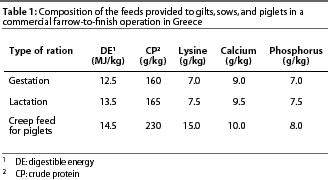
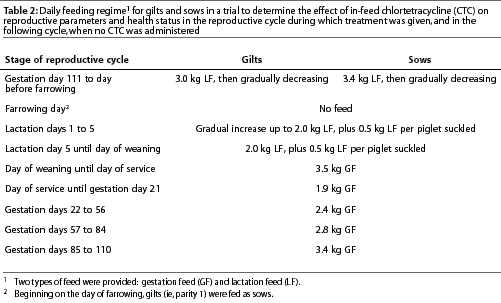
During Phase 1, starting 5 days before the expected day of farrowing, CTC was provided to CTC+ sows by means of a medicated supplement, which was 50% CTC premix (Aurofac, a granular premix containing 10% CTC; Hoffmann-La-Roche, now Alpharma, Oslo, Norway), 45% corn, and 5% sweetener (Arti-sweet; Feed Flavours Europe Ltd, Chester, England). To ensure the daily dose of CTC, 200 g of the supplement was top-dressed on the feed once daily for each CTC+ female. Sweetener was added to ensure full consumption of the medicated supplement. A placebo (control) top-dress supplement, which contained 95% corn and 5% sweetener, was top-dressed on the feed of each CTC- animal (200 g, once daily).
The top-dress supplements were prepared in a horizontal mixer. After preparation of a batch of medicated or control top-dress supplement, corn was passed through the mixer and discarded. Samples of each batch of medicated and control top-dress supplement were submitted for determination of CTC concentration (Quality Control Laboratory, Hoffmann-LaRoche, Basel, Switzerland). After preparation, top-dress supplements were stored in bags of two different colors, corresponding to the color of the sows' ear tags, in order to ensure that the correct supplement was fed to each experimental group. The person who prepared the feed was independent of the personnel responsible for feeding the animals and of the study monitor (herd veterinarian), who were therefore blinded to the content of the top-dress supplements.
Records and calculations
All female animals in the trial, and their piglets, were monitored daily by an experienced observer (herd veterinarian). Health status was assessed and signs of ill health were recorded.
According to the management policy applied in the study herd, females with severe, untreatable illness (eg, heatstroke) or illness unresponsive to 1 week of treatment, or those that failed to farrow for any reason other than abortion, were excluded from the trial. Females with a post-weaning anestrus interval of more than 30 days and those that returned to estrus more than twice were also excluded. A detailed post-mortem examination was carried out on all animals that died.
Also recorded were poor appetite (defined as consumption of less than half of the feed offered daily for 2 consecutive days), fever (rectal temperature >39.3°C for 2 consecutive days), clinical mastitis (defined as at least one abnormal mammary gland, changes in the appearance of mammary secretion, or both), and vaginal discharge (defined as purulent or blood-tinged discharge more than 5 days post-partum). Treatments administered during the trial were recorded.
For each litter of piglets, the following data were recorded: numbers of liveborn and stillborn piglets, number of piglets that died during lactation, number of weaned piglets, and individual body weights of piglets at birth and weaning.
Piglets were monitored daily for diarrhea. The severity of diarrhea was always assessed by the same observer. A modification of the diarrhea scoring system devised by Kelly et al13 was employed: 0 = no diarrhea, 1 = soft feces, 2 = fluid feces, 3 = severe diarrhea. For each litter, the daily diarrhea score (DDS) was calculated as follows: DDS = [P1 + (2xP2) + (3xP3)] / N, where P1 = number of piglets with a score of 1, P2 = number of piglets with a score of 2, P3 = number of piglets with a score of 3, and N = total number of piglets in the litter. The throughout-lactation diarrhea score (LDS) was calculated for each phase as follows: LDS = sum of the DDS / number of days of lactation.
For each sow or gilt, dates were recorded during Phase 1 for farrowing, weaning of piglets, first estrus, and mating after weaning of piglets. For Phase 2, dates were recorded for estrus and mating, farrowing, weaning of piglets, and first estrus and mating after weaning. The following intervalswere calculated: lactation length (Phase 1 and Phase 2), weaning-to-first-estrus interval (Phase 1 and Phase 2), and farrowing interval (number of days between the first and second farrowings). When weaning-to-first-estrus interval was calculated, a value of 9 days was assigned for anestrous sows.
The feed consumed daily by each sow, including the top-dress supplement, was calculated during lactation and during the weaning-to-first-estrus period by weighing the feed given to the sow and the unconsumed feed. During each phase of the study, each female was weighed at farrowing, at weaning of her piglets, and at the first subsequent estrus; sows were always weighed in the morning before feeding. Change in body weight during lactation and during the weaning-to-first-estrus period was calculated. The ratio of body weight gain (or loss) to feed consumed (G:F) was calculated as follows: G:F = body weight change (kg) over a given period / quantity of feed (kg) consumed during that period.
For each of the two treatment groups, the following parameters were also calculated: short weaning-to-first-estrus interval rate (the proportion of sows in a group with a weaning-to-first-estrus interval shorter than 8 days); anestrus rate (the proportion of sows in a group that failed to show signs of estrus within 30 days after weaning of their piglets, including a 7- to 8-day weaning-to-estrus interval and a 21-day breeding cycle); and return-to-estrus rate (the proportion of sows in a group that showed estrus more than once after weaning of their piglets).
Data analysis
Data were subjected to one-way analysis of variance using the General Linear Models of SAS (Version 8.1 for Windows, 2000; Statistical Analysis Systems Institute Inc, Cary, North Carolina). Differences between calculated parameters of the two groups were compared using a c2 test. When a marked deviation from normality was present (verified by Levene's test significance), data were transformed to homogenize such variations. Thus, for the data referring to G:F during the weaning-to-first-estrus periods and for the LDS data, a square root transformation was performed. Alternatively, a non-parametric analysis test (Mann-Whitney U test) was used in the case of data for which there was a marked departure from normality even after the appropriate transformations (ie, number of stillborn or weaned piglets).14
Results
Animals included in the trial and exclusions
Initially, 200 sows were assigned to each of the two treatment groups, and all animals farrowed and lactated normally. Parity distribution (Table 3) did not differ between the two groups.
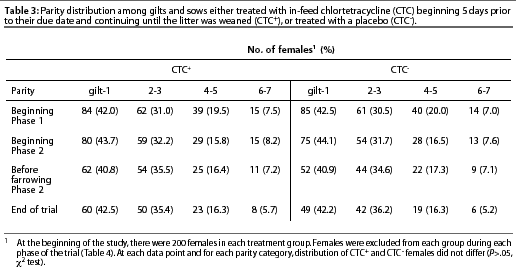
During Phase 1, 17 CTC+ sows and 30 CTC- sows were excluded from the study, and 183 CTC+ sows and 170 CTC- sows entered into Phase 2 (Table 4). Of these, 152 CTC+ sows and 127 CTC- sows farrowed and lactated normally. Subsequently, 11 CTC+ sows and 11 CTC- sows were excluded because of age or anestrus (Table 4). Therefore, 141 CTC+ sows and 116 CTC- completed both phases of the study. The full trial exclusion rate (for both Phase 1 and Phase 2) was greater (P =.009, c2 test) for the CTC- group (84 of 200 females excluded; 42.0%) than for the CTC+ group (59 of 200 females excluded; 29.5%). Reasons for exclusions are presented in Table 4. The proportion of excluded animals did not differ between the two groups for each of the reasons for exclusion except for anestrus in Phase 1 (Table 4).
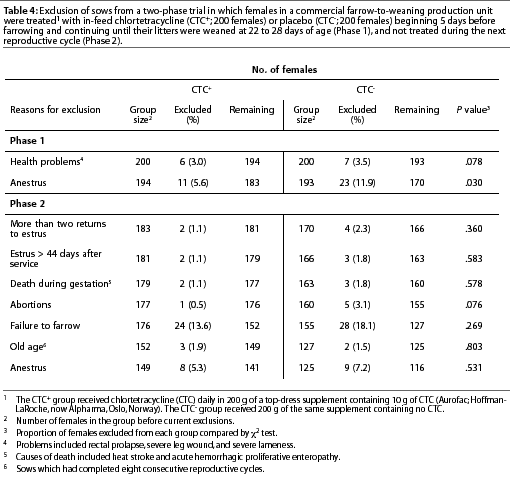
Health status data for sows and piglets
Fewer health problems were recorded among CTC+ females than among CTC- females (Table 5). Poor appetite and vaginal discharge were each observed in a smaller proportion of CTC+ females during both phases of the trial. Clinical mastitis was diagnosed in a smaller proportion of CTC+ sows during Phase 1. Moreover, a smaller proportion of CTC+ sows were individually treated for one or more of these health problems during both phases.
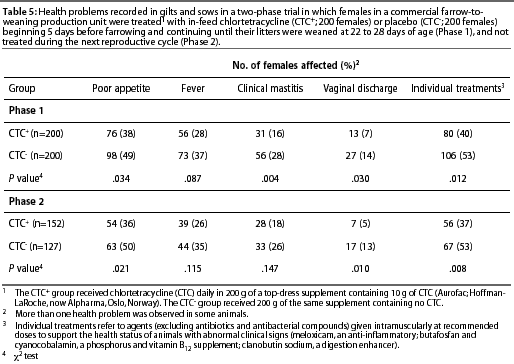
More piglets were weaned from CTC+ sows than from CTC- sows during both phases of the study (Table 6). This was a consequence of fewer dead piglets in the CTC+ group during lactation in Phase 1 and more liveborn piglets in the CTC+ group during Phase 2. Mean weaning weight was greater for the CTC+ piglets than for the CTC- piglets during Phase 1, and the mean LDS was lower for the CTC+ piglets than for the CTC- piglets in both phases (Table 6).
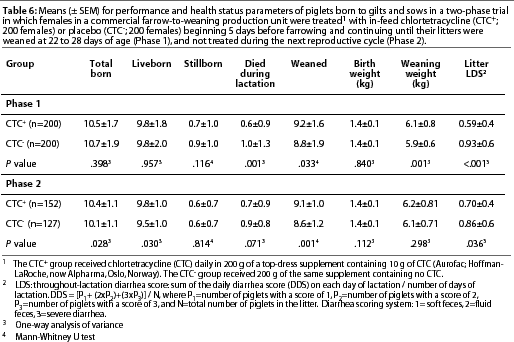
Performance data
Body weight did not differ among gilts and sows of the two treatment groups at farrowing, weaning, or the estrus after weaning, in either Phase 1 or Phase 2. Body weights for the CTC- sows ranged from 203.2 kg (SEM 21.5 kg) at the end of the first phase to 227.2 kg (SEM 20.7 kg) at farrowing in the second phase, and for the CTC+ sows, from 205.2 kg (SEM 22.1 kg) at the end of the first phase to 228.6 kg (SEM 20.1 kg) at farrowing in the second phase. However, in Phase 1, the CTC+ sows and gilts lost less weight than the CTC- sows and gilts during lactation and during the weaning-to-first-estrus period (Table 7).
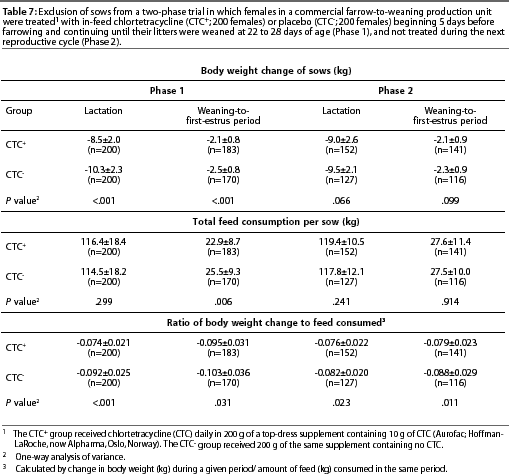
Feed consumption during lactation was not significantly different between the two groups; however, for every kg of feed intake, the CTC+ sows' body weight loss was smaller than that of the CTC- sows in both Phase 1 and Phase 2 (Table 7).
The farrowing interval was shorter for the CTC+ sows than for the CTC- sows, as a result of a shorter weaning-to-first-estrus interval in the CTC+ sows. No statistically significant differences were observed in the intervals between other reproductive events during the trial (Table 8).
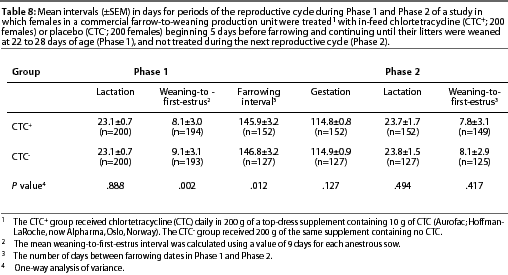
During Phase 1, more CTC+ sows had a weaning-to-first-estrus interval of <8 d than did CTC- sows, fewer CTC+ sows failed to show estrus, and fewer CTC+ sows returned to estrus after breeding (Table 9).
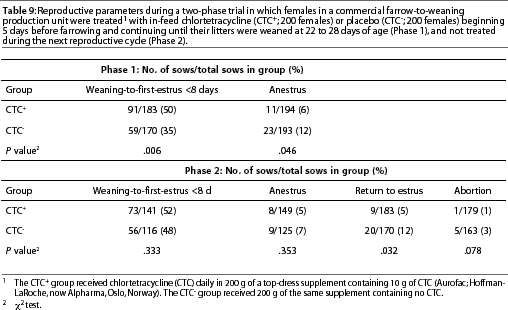
Discussion
The results of this study provide evidence of the beneficial effects of in-feed addition of CTC at a daily dose of 10 g per sow. Reproductive performance was improved in treated sows. This was also reflected in a lower exclusion rate among CTC+ animals, an observation which is in agreement with data from other studies on the use of CTC in sows during lactation.15
Tetracyclines are commonly used because of their broad spectrum of antimicrobial activity and desirable pharmacokinetic characteristics.16-19 However, relatively high concentrations of tetracyclines must be incorporated in the feed to achieve adequate blood concentration and ensure transfer to target organs, in this case, the reproductive tract and the mammary glands.10 This justifies our decision to use the high dose of 10 g CTC per sow daily. Dose-titration studies would be of interest.
The use of antimicrobials in post-parturient sows has been associated with a reduction in the number of microorganisms in the sow's reproductive tract and mammary glands, which might cause subclinical disorders.20,21 Among CTC+ sows, the lower incidence of poor appetite, clinical mastitis, and vaginal discharge, as well as the greater number and heavier body weight of weaned piglets, suggest a positive effect of CTC on the health status of sows during lactation. If individual treatments, rather than CTC treatment alone, had affected the outcome, the effect would have been in favor of the controls, since more CTC- sows than CTC+ sows were individually treated during each phase of the trial.
Sows with mastitis deprive the newborn piglets of colostrum: this reduces the survival and growth rate of sucking piglets and increases the severity of diarrhea.22-24 Hence, the better health status of the litters of treated sows, reflected by lower diarrhea scores, may also have been a consequence of the lower rate of occurrence of mastitis in CTC+ sows. Chlortetracycline is effective against several pathogens implicated in the etiology of diarrhea in piglets (eg, Escherichia coli, Clostridium perfringens).25 Concentration of tetracyclines in milk is 50 to 60% of that in plasma;26 therefore, it is possible that while the piglets nursed, CTC suppressed overgrowth of susceptible pathogens in their gastrointestinal tracts. The smaller number of dead piglets during Phase 1 lactation in group CTC+ sows was likely the consequence of less severe diarrhea of shorter duration among these piglets. Furthermore, the heavier weaning weight of Phase 1 piglets from CTC+ sows was likely due to better milk production by these sows, as a result of the lower incidence of clinical or perhaps subclinical mastitis.27
In Phase 1, CTC+ sows lost less body weight during lactation than
CTC- sows. This difference is in agreement with a previous report
on the use of in-feed CTC in sows during lactation.7 The growth-
promoting properties of CTC28 and consequent improvement in feed
efficiency may have been responsible for this observation. When the G:F ratio
was calculated, it was evident that the weight loss per kg of feed consumed
was less among CTC+ sows.
Maintenance of optimal body weight by sows throughout lactation is positively associated with subsequent reproductive performance.29-31 As gestation length is not easily changed, and lactation length is generally determined by type of management, the annual number of "non-productive" days is the most sensitive indicator, and perhaps one of the best measures, of reproductive performance.32,33 In this study, the farrowing interval between phases was shorter for CTC+ sows than for controls, mainly because of a shorter weaning-to-estrus interval and fewer returns to estrus in the CTC+ group. Therefore, sows treated with CTC had fewer "non-productive" days, ie, better reproductive performance. In addition, more CTC+ sows than controls had a weaning-to-estrus interval of less than 8 days, another useful measurement of reproductive performance.34
Reproductive performance of CTC+ sows was better even during Phase 2, when CTC was not administered, probably because they had lost less body weight than the CTC- sows. The health status of CTC+ sows continued to be better than that of CTC- sows during Phase 2, when neither group was treated with CTC. Treatment with CTC may have reduced excretion of bacteria into the environment, thus reducing the chances of reinfection with potential pathogens.
The better productivity of the CTC+ sows in Phase 2, compared to CTC- sows, may have been due to less weight loss during lactation and their shorter weaning-to-estrus interval post weaning. Both of these factors are associated with improved subsequent litter size.35
Ultimately, the beneficial effects of in-feed CTC in this study may be attributed to prevention of bacterial infection, as well as apparently better feed utilization. The primary consequence of treatment was improvement of the health status of both the sows and their litters during the reproductive cycle when the females were being medicated, with beneficial effects also observed during the subsequent lactation, when CTC was not administered.
Implications
- Sows treated with CTC top-dressed on the feed, at a daily dose of 10 g per sow starting 5 days before farrowing until appearance of estrous signs post weaning, had fewer health problems during lactation, such as mastitis, vaginal discharge, and poor appetite, compared to untreated sows.
- The health status of piglets born to sows treated with CTC was better than that of piglets born to untreated sows.
- More and heavier piglets were weaned from treated sows than from untreated sows.
- Treated sows lost less body weight per kg of feed intake during lactation and weaning-to-first-estrus periods than did untreated sows, mainly due to improved feed efficiency attributable to treatment with CTC.
- Weaning-to-first-estrus interval and farrowing-to-farrowing interval were shorter in the treated sows, and more treated sows had a weaning-to-first-estrus interval of less than 8 days, compared to untreated sows.
- The beneficial effects of CTC treatment extended to the subsequent reproductive cycle, when no treatment was administered.
References - refereed
2. Clark LK. Epidemiology and management of selected swine reproductive diseases. Anim Reprod Sci. 1996;42:447-454.
3. Hsu FS, Chen HW, Wung SC, Luchsinger JH, Fang WS. Effects of lincomycin on reproductive performance of sows. J Chin Soc Vet Sci. 1980;6:71-76.
4. Kyriakis SC, Vassilopoulos V, Demade I, Kissels W, Polizopoulou Z, Milner CK. The effect of virginiamycin on sow and litter performance. Anim Prod. 1992;55:431-436.
5. Kantas D, Vassilopoulos V, Kyriakis SC, Saoulidis K. A dose titration study on the effect of virginiamycin on gilt/sow and piglet performance. J Vet Med. A. 1998;45:525-533.
6. Giannakopoulos CG, Kyriakis SC, Saoulidis K, Spais A, Vassilopoulos V, Alexopoulos C. The effect of salinomycin on health status and performance of sows and their litters: a dose titration study. J Vet Med. A. 2001;48:257-265.
7. Maxwell CV, Combs GE, Knabe DA, Kornegay ET, Noland PR. Effect of dietary chlortetracycline during breeding and (or) farrowing and lactation on reproductive performance of sows: a cooperative study. J Anim Sci. 1994;72:3169-3176.
8. Soma JA, Speer VC. Effects of pregnant mare serum and chlortetracycline on the reproductive efficiency of sows. J Anim Sci. 1975;41:100-105.
9. Langlois BE, Cromwell GL, Hays VW. Influence of chlortetracyline in swine feed on reproductive performance and on incidence and persistence of antibiotic resistant enteric bacteria. J Anim Sci. 1978;46:1369-1382.
11. European Agency for the Evaluation of Medicinal Products. Guidelines on Good Clinical Practices. EMEA/CVMP/595/98. London, UK: EMEA; 1998.
12. National Research Council. Nutrient Requirements of Swine. 9th ed. Washington, DC: National Academy Press; 1988:21-25.
13. Kelly D, O'Brien JJ, McCracken KJ. Effect of creep feeding on the incidence, duration and severity of post-weaning diarrhoea in pigs. Res Vet Sci. 1990;49:223-228.
14. Petrie A, Watson P. Statistics for Veterinary and Animal Science. Oxford, UK: Blackwell Science Ltd; 1999.
16. Huber WG. Tetracyclines. In: Booth NH, McDonald LE, eds. Veterinary Pharmacology and Therapeutics. 6th ed. Ames, Iowa: Iowa State University Press; 1988:813-821.
17. Kilroy CR, Hall WF, Bane DP, Bevill RF, Koritz GD. Chlortetracycline in swine - bioavailability and pharmacokinetics in fed and fasted pigs. J Vet Pharm Ther. 1990;13:49-58.
18. DelCastillo JRE, Elsener J, Martineau GP. Pharmacokinetic modeling of in-feed tetracyclines in pigs using a meta-analytic compartmental approach. Swine Health Prod. 1998;6:189-202.
19. Boeckh A, Booth DM, Jones SAL. Tetracyclines. In: Aiello S, ed. The Merck Veterinary Manual, 8th ed. Whitehouse Station, New Jersey: Merck; 1998:1771-1775.
22. Backstrom L, Morkoc AC, Connor J, Larson R, Price W. Clinical study of mastitis-metritis-agalactia in sows in Illinois. JAVMA. 1984;185:70-73.
23. Martineau GP, Smith BB, Doize B. Pathogenesis, prevention and treatment of lactational insufficiency in sows. Vet Clin N Am Food Anim Pract. 1992;8:661-684.
24. Taylor DJ. Pig Diseases. 7th ed. Bury St Edmunds, UK: St Edmundsbury Press; 1999:354-360.
25. Cooper VL. Diagnosis of neonatal pig diarrhea. Vet Clin N Am Food Anim Pract. 2000;16:117-133.
26. Barragry TB. Veterinary Drug Therapy. Philadelphia, Pennsylvania: Lea & Febiger; 1994:264-293.
27. Klopfenstein C, Farmer C, Martineau GP. Diseases of the mammary glands and lactation problems. In: Straw BE, D'Allaire S, Mengeling WL, Taylor DJ, eds. Diseases of Swine. 8th ed. Ames, Iowa: Iowa State University Press; 1999:833-860.
28. Weissinger J. Miscellaneous growth promotants. In: Crawford LM, Franco DA, eds. Animal Drugs and Human Health. Lancaster, Pennsylvania: Technomic Publishing; 1994:113-124.
30. Close WH, Cole DJA. Nutrition of Sows and Boars. Nottingham, UK: Nottingham University Press; 2000:233-256.
31. Kyriakis SC. Anorexia-like wasting syndromes in pigs. In: Owen JB, Treasure JL, Collier DA, eds. Animal Models - Disorders of Eating Behaviour and Body Composition. Dordrecht, The Netherlands: Kluwer Academic Publishers; 2001:205-221.
33. Dial GD, Marsh WE, Polson DD, Vaillancourt JP. Reproductive failure: differential diagnosis. In: Leman AD, Straw BE, Mengeling WL, D'Allaire S, Taylor DJ, eds. Diseases of Swine. 7th ed. Ames, Iowa: Iowa State University Press; 1992:288-137.
34. Deen J, Dee S, Morrison RB, Radostits OM. Health and production management in swine herds. In: Radostits OM, ed. Herd Health: Food Animal Production Medicine. 3rd ed. Philadelphia, Pennsylvania: WB Saunders Company; 2001:635-764.
35. Dewey CE, Martin SW, Friendship RM, Wilson MR. The effects on litter size of previous lactation length and previous weaning-to-conception interval in Ontario swine. Prev Vet Med. 1994;18:213-223.
References - non refereed
1. Harding JCS. The economics of preventing disease introduction. Proc 26th Allen D. Leman Swine Conf. Minneapolis, Minnesota. 1999:185-191.
10. Cromwell GL. Subtherapeutic use of antibiotics for swine: performance, reproductive efficiency and safety issues. Proc 40th George A. Young Swine Health Manage Conf. Lincoln, Nebraska. 1999:70-87.
15. Deen J, Keay S, Boyd RD, Matzat P. Strategic application of Aureomycin" chlortetracycline granular premix in lactation diets reduces sow mortality and improves reproductive performance. Proc 31st AASP. Indianapolis, Indiana. 2000:99-102.
20. Murphy K, Friendship B. Post-farrowing vaginal discharge: a case study. Proc 28th AASP. Quebec City, Canada. 1997:99-102.
21. Kyriakis SC, Alexopoulos C. Metritis in sows. Proc Roche Vet Club. London, UK. 1998:2-5.
29. King RH. Nutritional anoestrus in young sows. Pig News Info. 1987;8:15-22.
32. Duffy SJ, Stein TE. Correlations between production, productivity and population factors in swine breeding herds. Proc 10th IPVS Cong. Lausanne, Switzerland. 1988:345.
